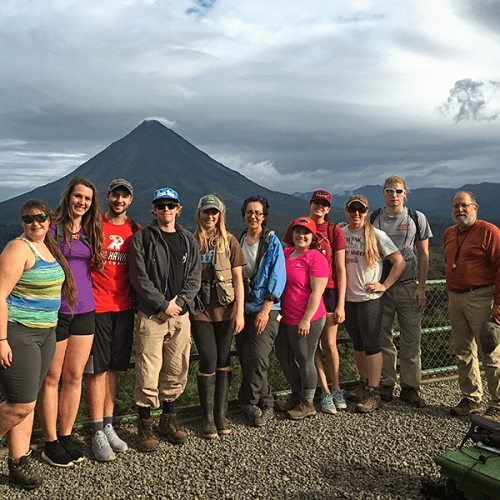Sarah Anderson ’10 honored as ESA Early Career Fellow
Posted June 25, 2025

At the halfway point in our trip, it was time to leave our cloud forest behind and head to the lowland forest of La Selva. We packed our bags, said goodbye to our mammal friend — the Coati — and journeyed down the road.
As we headed to Lake Arenal, the largest manmade lake in Costa Rica, we drove through a village that had been impacted by Nate. The tropical storm passed through the area in October. In its wake, large boulders had been moved up onto the pastures, and we were awed at the power of the storm. After passing the tiny village, we took in Arenal Volcano which is next to Lake Arenal. We boarded a boat to cross the lake. It took about 40 minutes to cross. Keeping in mind that Arenal is man-made, we found this extremely impressive.
While crossing the lake, we were informed that the previous village with the name Arenal was at that moment right below our boat. The people who lived in those homes had moved to make way for the hydroelectric project that would become Lake Arenal. When the water gets low enough, people in the area can see the tops of the homes left abandoned before the lake was filled.
After we arrived at the far side of the lake, we explored a private reserve, Mistico: Arenal Hanging Bridges Park and all its wonders. There are seven hanging bridges, ranging from 25 to 85 meters above the ground. While crossing the bridges, we were dazzled by the beauty around us. Crossing the bridges was exhilarating. Our knees shook from the bridges filled with people as we treaded lightly across.
After a vigorous hike through the Mistico forest, we came upon another view of Arenal Volcano — this time with no clouds above it. It is rare to see the volcano without clouds, so we took advantage of the precious moment.
Next, we headed to La Selva Biological Station. In the morning, we were awoken promptly at 4:45 a.m. by screeching howler monkeys. Their alarm was a scary, adrenaline-fueled surprise that is better than any morning coffee, guaranteed. The howler monkeys greeted us on the way to breakfast by blocking the only bridge we could use to cross the Rio Puerto Viejo. We stood and watched the monkeys as long as they would let us, and as we crossed the bridge we took as many quick photos of these enthusiastic monkeys that woke us bright and early.
Later that day, we traveled to Tirimbina Biological Reserve. There we tested the water quality of the Sarapiqui River. Testing the water quality requires three stages, each consisting of an intricate setup and several methods. The three stages include a physical test, a chemical test and a biological test. One indicator of a healthy river is to find pollution-sensitive macro-invertebrates, one of which was a dobsonfly larvae. That very night, we observed an adult dobsonfly. All of our samples from the Sarapiqui showed positive signs that it was indeed a healthy and well-balanced river.
Stay tuned for more exciting adventures!
Lateesha Hiser ’18
Douglas, Wyoming
Grant Grywalsky ’19
Madison, Wisconsin